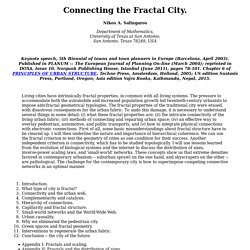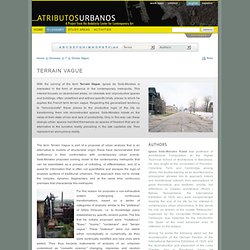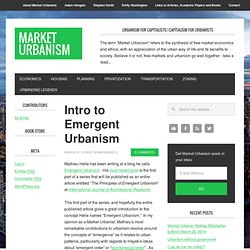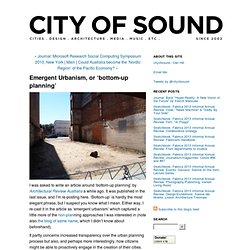

Urban complexity in the practice of urbanism. "Connecting the Fractal City", by Nikos A. Salingaros. Nikos A.

SalingarosDepartment of Mathematics, University of Texas at San Antonio, San Antonio, Texas 78249, USAKeynote speech, 5th Biennial of towns and town planners in Europe (Barcelona, April 2003). Published in PLANUM -- The European Journal of Planning On-line (March 2004); reprinted in DOXA, Issue 10, Norgunk Publishing House, Istanbul (June 2011), pages 78-101. Chapter 6 of PRINCIPLES OF URBAN STRUCTURE, Techne Press, Amsterdam, Holland, 2005; US edition Sustasis Press, Portland, Oregon; Asia edition Vajra Books, Kathmandu, Nepal, 2015. Living cities have intrinsically fractal properties, in common with all living systems. The pressure to accommodate both the automobile and increased population growth led twentieth-century urbanists to impose anti-fractal geometrical typologies. Introduction.
Figure 12. SPLACE - architecture photography exhibitions graphics. Prosthetic Unplanned Urbanism -Messy, Vital. Urban Attributes - Andalusia Center for Contemporary Art. With the coining of the term Terrain Vague, Ignasi de Solà-Morales is interested in the form of absence in the contemporary metropolis.

This interest focuses on abandoned areas, on obsolete and unproductive spaces and buildings, often undefined and without specific limits, places to which he applies the French term terrain vague. Regarding the generalized tendency to "reincorporate" these places to the productive logic of the city by transforming them into reconstructed spaces, Solà-Morales insists on the value of their state of ruin and lack of productivity. Only in this way can these strange urban spaces manifest themselves as spaces of freedom that are an alternative to the lucrative reality prevailing in the late capitalist city.
They represent an anonymous reality. The term Terrain Vague is part of a proposal of urban analysis that is an alternative to models of structuralist origin; these have demonstrated their inefficiency in their confrontation with contemporary urban events. Six trending urbanist themes for 2012. The urbanist calendar published on Monday was, admittedly, a visual provocation, setting a stage for thought about important urban issues for 2012.

I see great merit in such urban exploration with a descriptive, rather than prescriptive approach. But there is another provocation—from 2011 professional experiences and featured articles—that offer several themes that I expect will also endure. Here is a synthesis of themes to watch, and why, based on my own encounters, and those of clients and friends. As illustration, I offer citation to several of my articles as they reappeared in the trend-capturing Planetizen (after original appearance in one or more of myurbanist, The Atlantic, The Atlantic Cities, The Huffington Post, Grist, Sustainable Cities Collective and Crosscut) .
The themes span six subject areas, below. More Roles for Social Media Evolving communication technology has forever changed how we analyze and discuss the city. Make No Little Plans Without Twitter Urbanism Without Effort. Rediscovering urban complexity. Sahra:denCity (1of2) Parametric Urbanism - Urban Reef - by Shampoo. Intro to Emergent Urbanism. Mathieu Helie has been writing at a blog he calls Emergent Urbanism.

His most recent post is the first part of a series that will be published as an entire article entitled “The Principles of Emergent Urbanism” at International Journal of Architectural Research. This first part of the series, and hopefully the entire published article gives a great introduction to the concept Helie names “Emergent Urbanism.” In my opinion as a Market Urbanist, Mathieu’s most remarkable contributions to urbanism revolve around the concepts of “emergence” as it relates to urban patterns, particularly with regards to Hayek’s ideas about “emergent order” or “spontaneous order”. As Mathieu writes: How is it possible for what is obviously a human artifact to arise as if by an act of nature? The most devastating criticism of modernist urban planning came in the form of a sociological study and personal defense of the spontaneous city, the book The Death and Life of Great American Cities by Jane Jacobs. Urban Planning, Entertainment & Film Case Studies.
Emergent Urbanism, or ‘bottom-up planning’ I was asked to write an article around ‘bottom-up planning’ by Architectural Review Australia a while ago.

It was published in the last issue, and I’m re-posting here. ‘Bottom-up’ is hardly the most elegant phrase, but I suspect you know what I mean. Either way, I re-cast it in the article as ‘emergent urbanism’ which captured a little more of the non-planning approaches I was interested in (note also the blog of same name, which I didn’t know about beforehand). It partly concerns increased transparency over the urban planning process but also, and perhaps more interestingly, how citizens might be able to proactively engage in the creation of their cities.
While it applies to Australian cities most closely, I hope the ideas here might be more generally interesting. And for those of you outside Australia, there are a few subtitles required to read this.